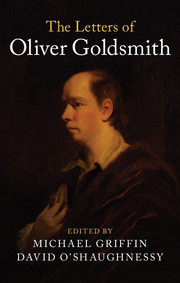18 - To Lloyd's Evening Post, London, 17 November 1762
Summary
Goldsmith's biography of Richard Nash (1674–1761) was published anonymously on 14 October 1762. A second edition followed on 9 December. The Life of Richard Nash, Esq; Late Master of the Ceremonies at Bath was compiled and composed by Goldsmith from Nash's papers and the anecdotes of Nash's executor George Scott. Nash, also known as Beau Nash, was a social celebrity famed for generous extravagance, and the Life – an engaging, anecdotal and, at times, critical narrative of Nash's life – is perhaps Goldsmith's best-known biographical work. It was not particularly well received however. The Monthly and Critical reviews deemed its subject matter, and its manner, trivial, while in its issue of October 1762, the St. James's Magazine took additional issue with its apparent attribution to ageing actor James Quin (1693–1766) of a letter to an unnamed nobleman indicating Quin's supposed designs on Nash's position as Master of Ceremonies at Bath in October 1760, a matter of months before the latter's death. Quin's supposed letter was mediated to Nash, Goldsmith reported, by a third party, and was thus found among Nash's papers – hence its inclusion in the Life. Goldsmith did not explicitly endorse Quin's authorship of the letter, but its inclusion was read as a tacit attribution. The St. James's Magazine reviewer deemed the attribution an absurdity, and his review was followed with a letter to the editor with an epigram ridiculing Goldsmith for his alleged folly.
Just over three weeks later a letter to the editor appeared in Lloyd's Evening Post defending the author of the Life of Nash. Signed ‘A. B.’, this letter, Arthur Friedman has all but conclusively demonstrated, was composed by Goldsmith (see CW, III: 392–4), and thus we include it here.1 The grounds given by Friedman for its inclusion are several: the penultimate paragraph of the letter was slightly altered and included as a footnote in the second edition of the Life just two weeks after the letter appeared in Lloyd’s. It is likely, therefore, that the paragraph had been prepared and copy for the new edition dispatched before the letter appeared in the newspaper. Friedman also noted that Goldsmith was writing for no other periodicals at the time, having published five essays in Lloyd's over the first half of 1762.
- Type
- Chapter
- Information
- The Letters of Oliver Goldsmith , pp. 53 - 58Publisher: Cambridge University PressPrint publication year: 2018



